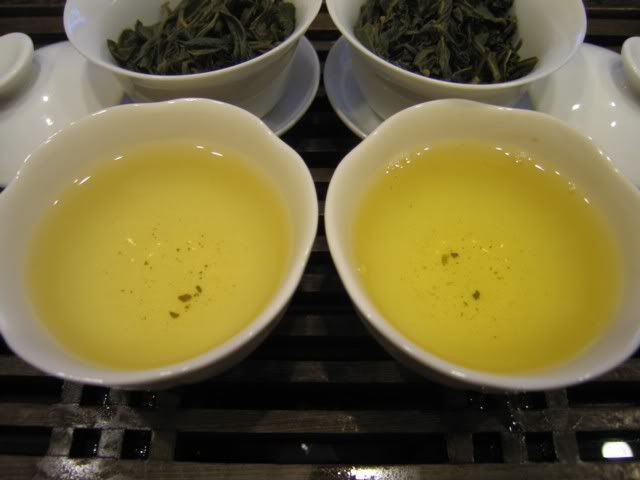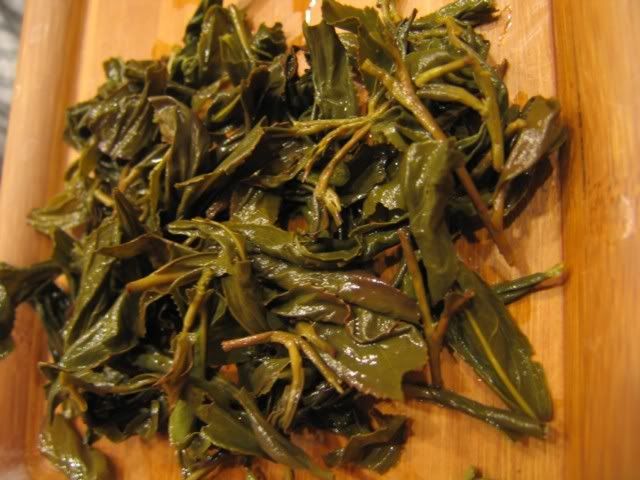Since I bought two packs of different grades of baozhongs last weekend… I should actually try them.
Generally speaking, I’m not a big baozhong drinker. Nor, for the matter, am I a big Taiwan oolong drinker in general. That’s largely because my body doesn’t take it too well. A lot of Taiwan oolongs are really green these days with low oxidation and little to no roasting. It’s a bit much for me sometimes. But when in Rome… act like the Romans do, I guess.
The teas are actually almost indistinguishable in dry form.

Or, for that matter, in the brewed form

Any differences in colour you see is mostly due to the slight difference in positioning relative to the light source. I’d say that if I had given one of these to you and asked you to guess, your chance of getting it right would not be much higher than 50%.
There is a bit of a difference in the dry leaves — the aroma coming from the tea when it hits the warmed gaiwan. The cheaper one (left) has a slight smell of something grainy — a little like some kind of lightly toasted grains. The right one is more floral — smelling like a gaoshan oolong.
The same is largely reflected in the taste. The left one is clearly the weaker tea, tasting a bit more watery, while the right one is more full bodied, with a deeper and more complex flavour. The teas are hard to tell apart when dry, but when in tea form and drunk, anybody with a tongue can probably tell which one is better. I used the same amount of tea in both gaiwan, measured by my scale, and the difference in taste is obvious. The better one also lasted longer — about 5 infusions, whereas the weaker one was tasting watery earlier. You might even say it tasted watery right away.
Then again, the better one is double the price of the cheap one. So you do pay for what you get.
The wet leaves…. look similar, although I feel that the expensive one is a little more sturdy than the cheap one. It’s quite subtle though, the differences.
This is the cheap one

And the better one

So, the difference is really pretty much all in the taste (and smell). It was interesting, if nothing else. I still prefer them roasted.
P.S. I really need to fix the lighting situation for picture taking. It’s horrible 🙁

 RSS - Posts
RSS - Posts
5 responses so far ↓
shichangpu // August 24, 2007 at 9:36 pm |
i’m curious: do you find that the lightly oxidised taiwan oolongs affect your system negatively to a greater degree than young sheng?
MarshalN // August 25, 2007 at 12:12 am |
Yes, oddly enough. You’d think that won’t be the case, but it is.
I have a feeling that somehow the Taiwanese oolong leaves are perhaps more stimulating than young sheng. I really don’t have a good explanation for this.
shichangpu // August 25, 2007 at 12:48 am |
interesting. i can’t think of an explanation either. i still have trouble with young sheng, but don’t seem to have a problem with light oolongs–taiwanese or otherwise. however, i rarely drink light oolongs, and for better or worse young sheng seems unavoidable…
MarshalN // August 25, 2007 at 1:10 am |
Well, my guess would be that Yunnan teas are somehow more ok than light oolongs for my body. It might have to do with climate, age when plucked, etc
Who knows… but I definitely don’t feel too good after a few cups of light Taiwan oolongs, normally. Better if I have eaten right before, and definitely should not drink that stuff near the end of a tea session.
juliantai // August 26, 2007 at 2:33 am |
Marshall
Hey interesting post with the comparison.
I totally agree with you it is very hard to tell them apart other them tasting them.
The second photo showing the “wet leaves” actually has smaller leaves, although I am not entirely sure if it is really so.
The second photo also seems to have bigger stems.
Higher end oolongs tend to be either picked earlier in the season, or have healthier, bigger, better grown leaves. But again, not always the case.
The amazing things about these lightly oxidised teas is how beautiful these “wet” leaves are. Amazing.